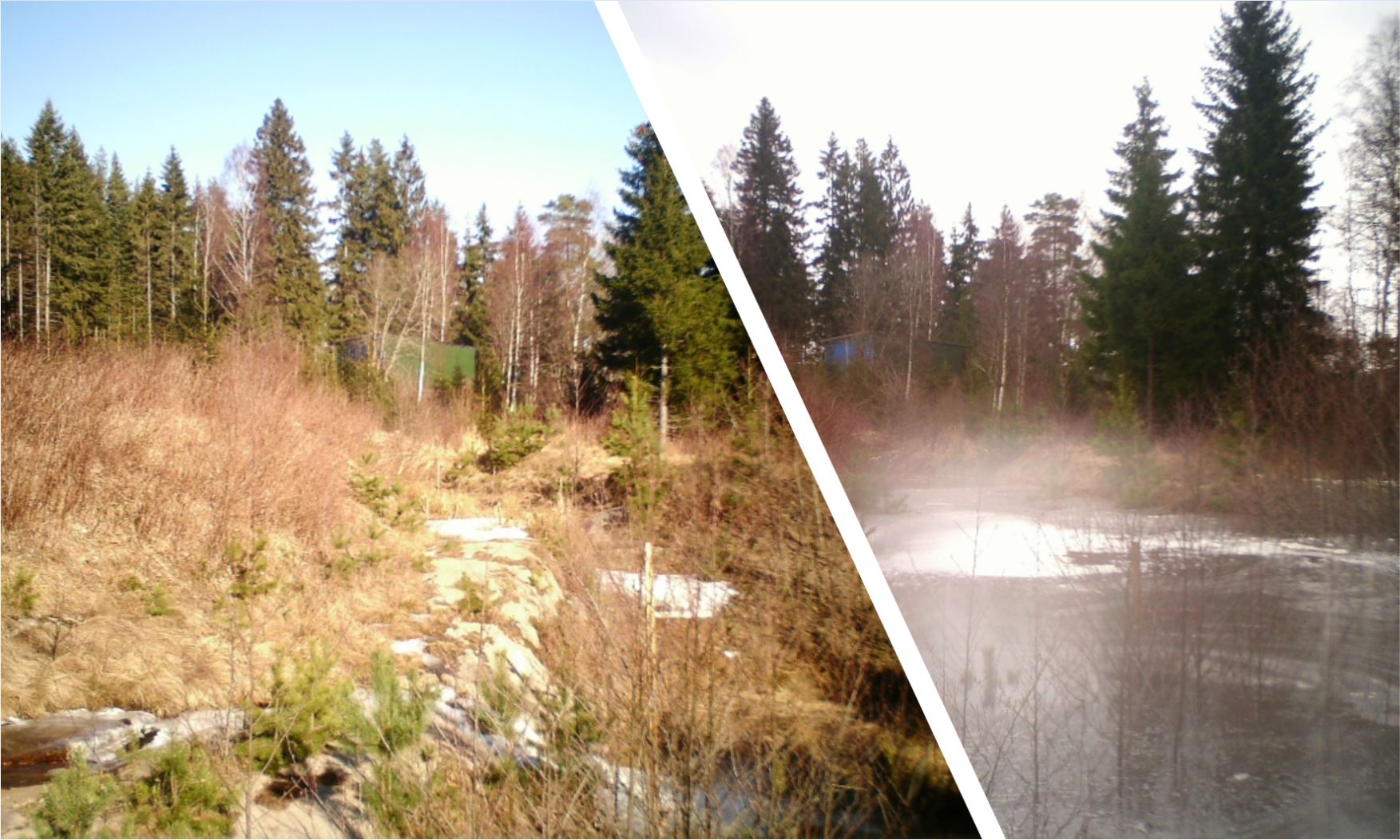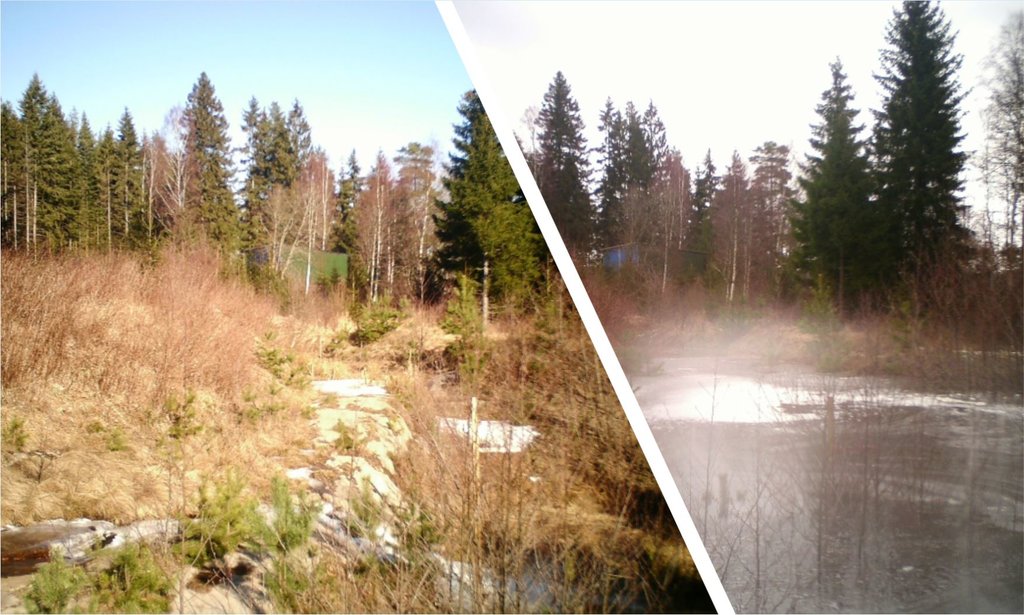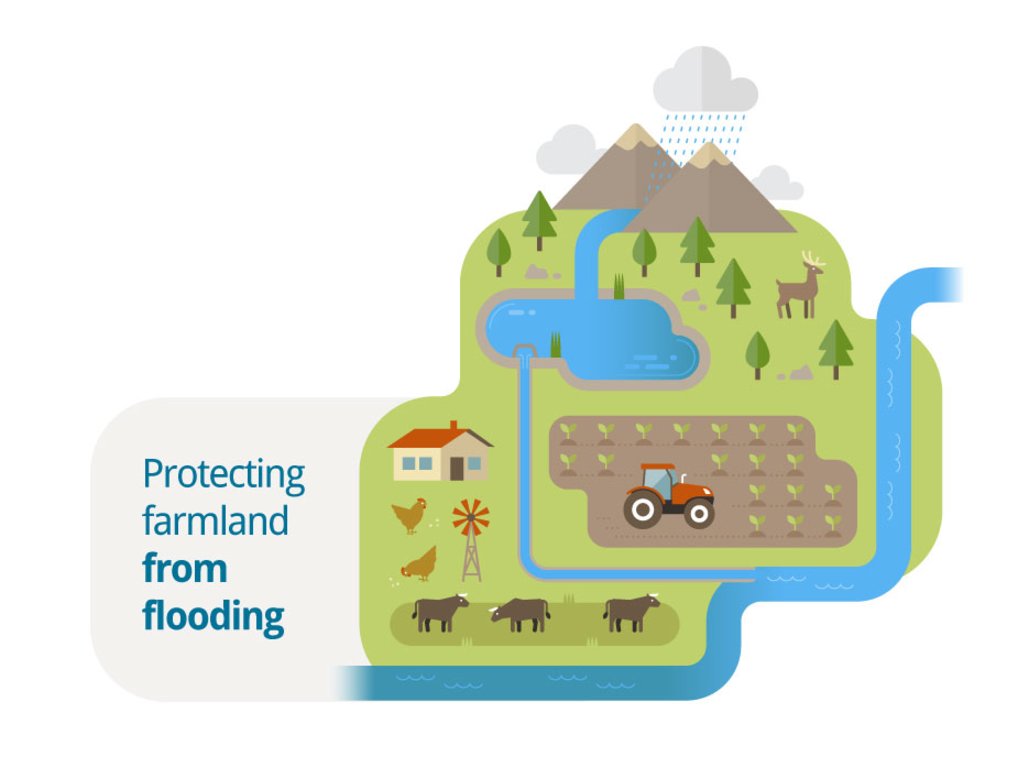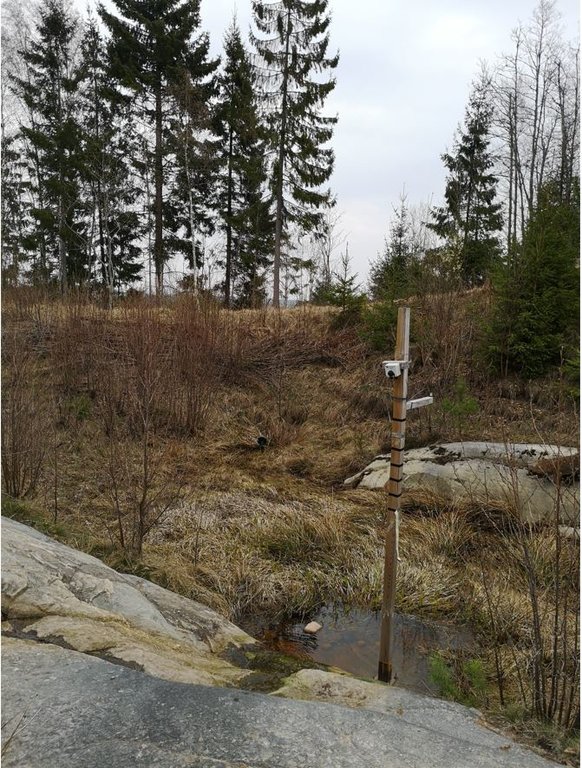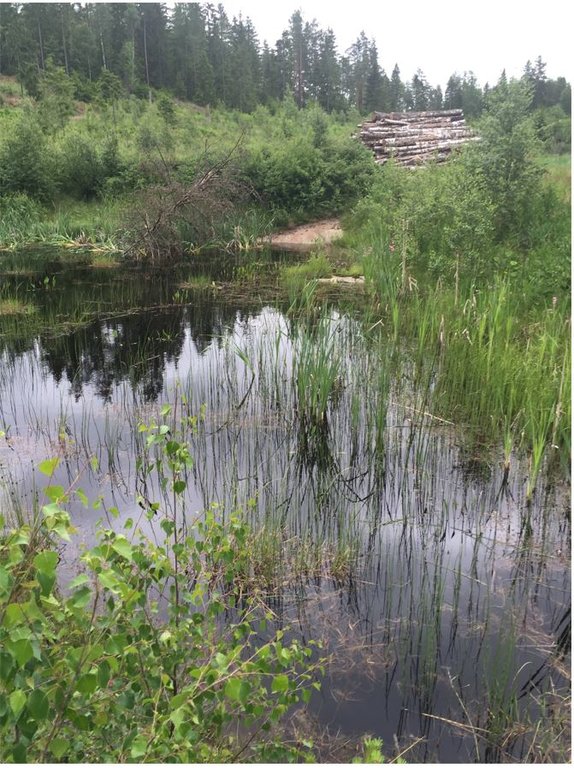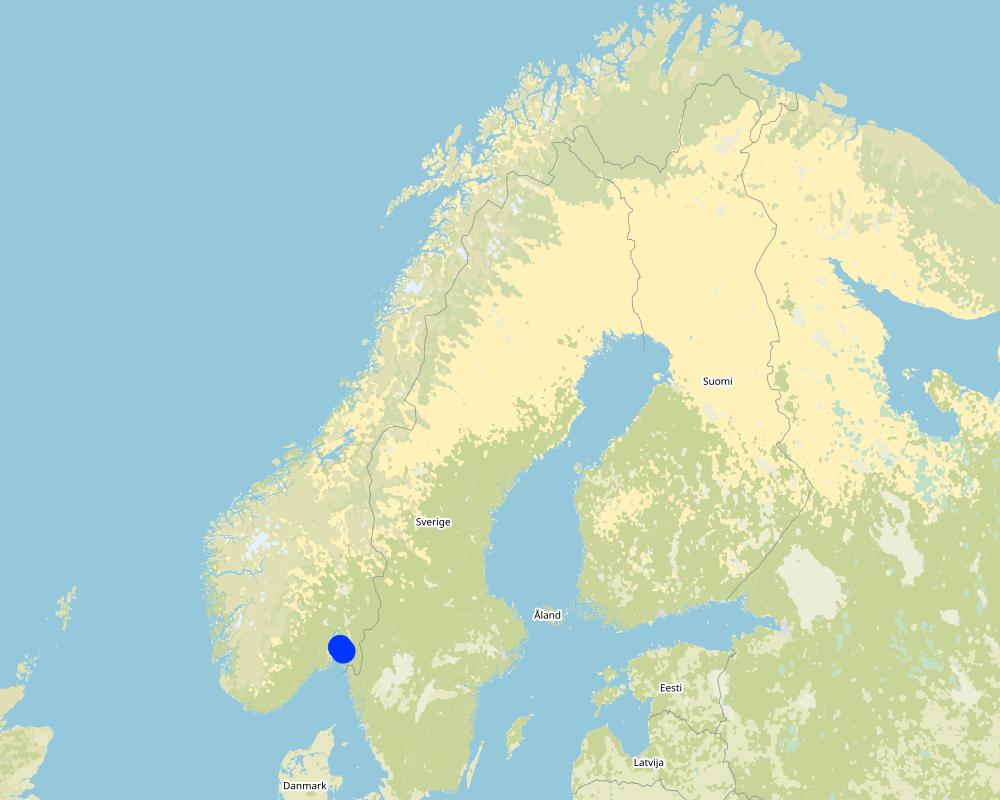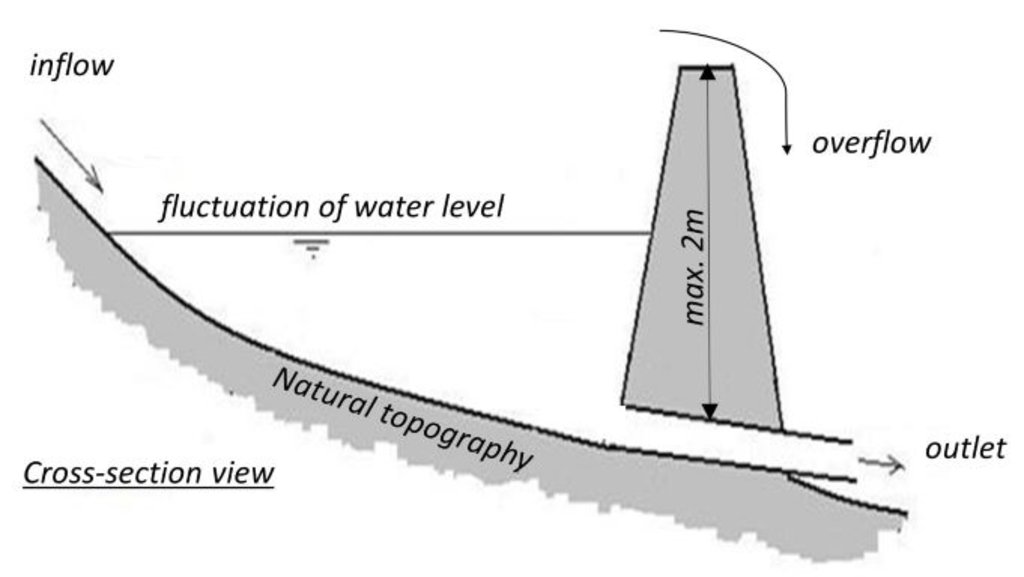Small retention ponds in the forest [Norway]
- Creation:
- Update:
- Compiler: Dominika Krzeminska
- Editor: Jannes Stolte
- Reviewers: William Critchley, Rima Mekdaschi Studer
“Mindre” fordrøyningsdammer
technologies_6156 - Norway
View sections
Expand all Collapse all1. معلومات عامة
1.2 Contact details of resource persons and institutions involved in the assessment and documentation of the Technology
SLM specialist:
Name of project which facilitated the documentation/ evaluation of the Technology (if relevant)
Preventing and Remediating degradation of soils in Europe through Land Care (EU-RECARE )Name of project which facilitated the documentation/ evaluation of the Technology (if relevant)
OPtimal strategies to retAIN and re-use water and nutrients in small agricultural catchments across different soil-climatic regions in Europe (OPTAIN)Name of the institution(s) which facilitated the documentation/ evaluation of the Technology (if relevant)
Norwegian Institute of Bioeconomy Research (NIBIO) - Norway1.3 Conditions regarding the use of data documented through WOCAT
The compiler and key resource person(s) accept the conditions regarding the use of data documented through WOCAT:
نعم
1.4 Declaration on sustainability of the described Technology
Is the Technology described here problematic with regard to land degradation, so that it cannot be declared a sustainable land management technology?
لا
1.5 Reference to Questionnaire(s) on SLM Approaches (documented using WOCAT)
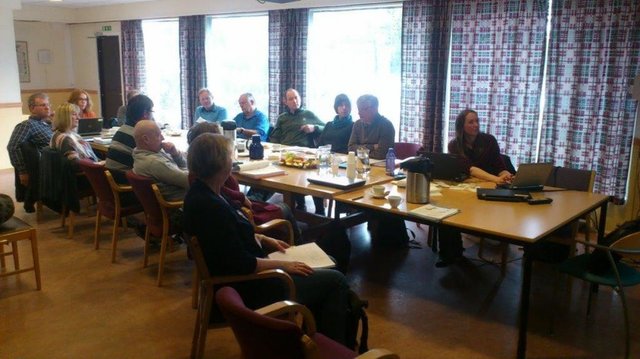
Regional Environmental program [Norway]
Regulations and financial grants for reduction of pollution and promotion of the cultural landscape.
- Compiler: Kamilla Skaalsveen
2. Description of the SLM Technology
2.1 Short description of the Technology
Definition of the Technology:
Small retention ponds, located in the forest, are ponds or pools with sufficient storage capacity to store the surface runoff to prevent flooding during heavy rainfall events. Ponds contain limited or no water during dry weather, but are designed to retain water during rain events.
2.2 Detailed description of the Technology
Description:
The aim of the small retention ponds is to provide additional storage capacity to hold runoff to attenuate surface runoff - and thus reduce its impact on flooding - during rainfall events. The measure will primarily be useful in connection with short-term extreme episodes and have less effect during prolonged rain – this is because once the dam is filled up it no longer has a flood-reducing effect.
Small retention ponds located in forest areas are artificial dams (up to 2m height, for security reasons) made of soil, stone and/or gabions, with additional storage capacity to attenuate surface runoff during rainfall events. The ponds use local topography to provide space to store discharge peaks. The size of the ponds vary greatly between c. 50-150 m3. The dams can either be established in waterways, or next to the stream so that water is diverted during a flood event. Continuous water flow through the dam is ensured by a spillway located at the bottom of the dam. In this way, the dam can temporarily store water during rainfall episodes and thus decrease the flood peak downstream. The pond must be designed correctly, and calculations of cost-benefit should be carried out before implementation.
As for now, the implementation of small retention ponds in the forests are initiated by landowners. The ponds are getting more and more interest from the local communities however, they are not yet commonly implemented.
In general, there is agreement between experts (researchers) and other stakeholders about the benefits of the implementation of small retention ponds in the forest. However, it is not always the case that such retention ponds decrease floods - as the level of influence depends on the scale and the number of ponds within the catchment. When it comes to drawbacks, stakeholders were particularly worried about the cost of building and maintaining the retention ponds as well as the security of the construction. They placed less emphasis on possible decreases in forest production, which was one of the disadvantages identified by researchers.
Information about the technology is based on investigations and/or reports from different catchments in Norway. For the purpose of the OPTAIN project, the technology is further presented in the natural and human environment context of the Kråkstad River catchment - a Norwegian Case Study catchment within the OPTAIN project.
The Kråkstad River is mainly situated in Ski municipality in South-Eastern parts of Norway. The river catchment is a western tributary of the Vansjø-Hobøl watercourse, also known as the Morsa watercourse. The Kråkstad River catchment area is about 51 km², 43% of which is agricultural land, where cereals are produced on heavy clay soils. The main environmental challenge in the area is water quality (incl. high phosphorus pollution) and soil erosion (incl. riverbank erosion and quick-clay landslides).The Morsa watercourse is a drinking water resource and there are specific environmental regulations for land management followed by subsidies through the Regional Environmental Programme (RMP).
2.3 Photos of the Technology
2.5 Country/ region/ locations where the Technology has been applied and which are covered by this assessment
بلد:
Norway
Region/ State/ Province:
Viken county
Further specification of location:
The Vansjø - Hobøl catchment
Specify the spread of the Technology:
- applied at specific points/ concentrated on a small area
Is/are the technology site(s) located in a permanently protected area?
لا
Map
×2.6 Date of implementation
If precise year is not known, indicate approximate date:
- less than 10 years ago (recently)
2.7 Introduction of the Technology
Specify how the Technology was introduced:
- through land users' innovation
- during experiments/ research
- SMIL
Comments (type of project, etc.):
Establishment of the retention ponds presented in this documentation was initiated by landowners. Monitoring of their effectiveness was part of the research project (RECARE: https://www.recare-hub.eu/).
Retention ponds are part of SMIL subside system (Special Environmental measures in Agriculture)
3. Classification of the SLM Technology
3.1 Main purpose(s) of the Technology
- reduce, prevent, restore land degradation
- preserve/ improve biodiversity
- reduce risk of disasters
- adapt to climate change/ extremes and its impacts
- mitigate climate change and its impacts
3.2 Current land use type(s) where the Technology is applied
Land use mixed within the same land unit:
لا

Forest/ woodlands
- natural forest
3.3 Has land use changed due to the implementation of the Technology?
Has land use changed due to the implementation of the Technology?
- No (Continue with question 3.4)
3.4 Water supply
Water supply for the land on which the Technology is applied:
- rainfed
3.5 SLM group to which the Technology belongs
- water diversion and drainage
- surface water management (spring, river, lakes, sea)
3.6 SLM measures comprising the Technology

structural measures
- S5: Dams, pans, ponds
3.7 Main types of land degradation addressed by the Technology

soil erosion by water
- Wt: loss of topsoil/ surface erosion
- Wg: gully erosion/ gullying
3.8 Prevention, reduction, or restoration of land degradation
Specify the goal of the Technology with regard to land degradation:
- prevent land degradation
- reduce land degradation
4. Technical specifications, implementation activities, inputs, and costs
4.1 Technical drawing of the Technology
Technical specifications (related to technical drawing):
Cross-section view on the small retention pond
Author:
Dominika Krzeminska
Date:
26/01/2022
4.2 General information regarding the calculation of inputs and costs
Specify how costs and inputs were calculated:
- per Technology unit
Specify unit:
Pond
Specify dimensions of unit (if relevant):
c. 50-150 m3
other/ national currency (specify):
NOK
If relevant, indicate exchange rate from USD to local currency (e.g. 1 USD = 79.9 Brazilian Real): 1 USD =:
8,89
Indicate average wage cost of hired labour per day:
c.a. 3000 NOK (it is only the cost of the time assuming 8h work per day, 320-500 NOK/hour; person; machinery, equipment, materials not included)
4.3 Establishment activities
| Activity | Timing (season) | |
|---|---|---|
| 1. | Construct the dam | dry period of the year |
Comments:
We are talking here about “small” dams, up to 2 m (restrictions due to safety regulations). The dams can be built with the use of typical machinery available at the farms: digger, tractor etc. or with help of company.
4.4 Costs and inputs needed for establishment
If you are unable to break down the costs in the table above, give an estimation of the total costs of establishing the Technology:
35000,0
If land user bore less than 100% of costs, indicate who covered the remaining costs:
The landowners can apply for subsidies to establish and maintenance sedimentation pond, within SMIL system (Special Environmental measures in Agriculture). Local county authorities are responsible for the administration of these schemes.
Comments:
Approximately NOK 35,000 has been used to establish the retention pond (monitoried withn RECARE project). It is mostly to rent the equipment and buy the material (soil). The work was done made by the landowner.
4.5 Maintenance/ recurrent activities
| Activity | Timing/ frequency | |
|---|---|---|
| 1. | Maintenance of the dam | on demand |
| 2. | Maintenance of the pond area | on demand |
4.6 Costs and inputs needed for maintenance/ recurrent activities (per year)
If you are unable to break down the costs in the table above, give an estimation of the total costs of maintaining the Technology:
10000,0
If land user bore less than 100% of costs, indicate who covered the remaining costs:
The landowners can apply for subsidies to establish and maintenance sedimentation pond, within SMIL system (Special Environmental measures in Agriculture). Local county authorities are responsible for the administration of these schemes.
Comments:
An estimate for maintenance costs is set at NOK 10,000 annually, most of it is for clearing the area.
4.7 Most important factors affecting the costs
Describe the most determinate factors affecting the costs:
- The terrain setup,
- Type of material used to construct the dam and its durability (establishment and maintenance costs).
- Need for maintenance
The landowners can apply for subsidies to establish and maintenance sedimentation pond, within SMIL system (Special Environmental measures in Agriculture). Local county authorities are responsible for the administration of these schemes.
5. Natural and human environment
5.1 Climate
Annual rainfall
- < 250 mm
- 251-500 mm
- 501-750 mm
- 751-1,000 mm
- 1,001-1,500 mm
- 1,501-2,000 mm
- 2,001-3,000 mm
- 3,001-4,000 mm
- > 4,000 mm
Agro-climatic zone
- humid
5.2 Topography
Slopes on average:
- flat (0-2%)
- gentle (3-5%)
- moderate (6-10%)
- rolling (11-15%)
- hilly (16-30%)
- steep (31-60%)
- very steep (>60%)
Landforms:
- plateau/plains
- ridges
- mountain slopes
- hill slopes
- footslopes
- valley floors
Altitudinal zone:
- 0-100 m a.s.l.
- 101-500 m a.s.l.
- 501-1,000 m a.s.l.
- 1,001-1,500 m a.s.l.
- 1,501-2,000 m a.s.l.
- 2,001-2,500 m a.s.l.
- 2,501-3,000 m a.s.l.
- 3,001-4,000 m a.s.l.
- > 4,000 m a.s.l.
5.3 Soils
Soil depth on average:
- very shallow (0-20 cm)
- shallow (21-50 cm)
- moderately deep (51-80 cm)
- deep (81-120 cm)
- very deep (> 120 cm)
Soil texture (topsoil):
- medium (loamy, silty)
- fine/ heavy (clay)
Soil texture (> 20 cm below surface):
- medium (loamy, silty)
- fine/ heavy (clay)
Topsoil organic matter:
- medium (1-3%)
5.4 Water availability and quality
Ground water table:
< 5 m
Availability of surface water:
good
Water quality (untreated):
for agricultural use only (irrigation)
Water quality refers to:
both ground and surface water
Is water salinity a problem?
لا
Is flooding of the area occurring?
نعم
Regularity:
frequently
5.5 Biodiversity
Species diversity:
- medium
Habitat diversity:
- medium
5.6 Characteristics of land users applying the Technology
Sedentary or nomadic:
- Sedentary
Market orientation of production system:
- mixed (subsistence/ commercial)
Off-farm income:
- > 50% of all income
Relative level of wealth:
- average
- rich
Individuals or groups:
- individual/ household
Level of mechanization:
- mechanized/ motorized
Gender:
- women
- men
Age of land users:
- youth
- middle-aged
5.7 Average area of land used by land users applying the Technology
- < 0.5 ha
- 0.5-1 ha
- 1-2 ha
- 2-5 ha
- 5-15 ha
- 15-50 ha
- 50-100 ha
- 100-500 ha
- 500-1,000 ha
- 1,000-10,000 ha
- > 10,000 ha
5.8 Land ownership, land use rights, and water use rights
Land ownership:
- individual, titled
Land use rights:
- communal (organized)
- individual
Water use rights:
- open access (unorganized)
5.9 Access to services and infrastructure
health:
- poor
- moderate
- good
education:
- poor
- moderate
- good
technical assistance:
- poor
- moderate
- good
employment (e.g. off-farm):
- poor
- moderate
- good
markets:
- poor
- moderate
- good
energy:
- poor
- moderate
- good
roads and transport:
- poor
- moderate
- good
drinking water and sanitation:
- poor
- moderate
- good
financial services:
- poor
- moderate
- good
6. Impacts and concluding statements
6.1 On-site impacts the Technology has shown
Socio-economic impacts
Production
crop production
risk of production failure
production area
Income and costs
farm income
Comments/ specify:
Less flooding events--> crop grown
Ecological impacts
Soil
soil loss
Comments/ specify:
Less flooding events--> lower soil erosion
Biodiversity: vegetation, animals
plant diversity
animal diversity
habitat diversity
6.2 Off-site impacts the Technology has shown
downstream flooding
Comments/ specify:
Depending on the scale and number of retention pond in the catchment, it may affect the discharge behavior of the river system (less peak flows).
6.3 Exposure and sensitivity of the Technology to gradual climate change and climate-related extremes/ disasters (as perceived by land users)
Gradual climate change
Gradual climate change
| Season | increase or decrease | How does the Technology cope with it? | |
|---|---|---|---|
| annual temperature | increase | well | |
| seasonal rainfall | wet/ rainy season | increase | well |
Climate-related extremes (disasters)
Meteorological disasters
| How does the Technology cope with it? | |
|---|---|
| local rainstorm | moderately |
| local windstorm | well |
Hydrological disasters
| How does the Technology cope with it? | |
|---|---|
| general (river) flood | well |
6.4 Cost-benefit analysis
How do the benefits compare with the establishment costs (from land users’ perspective)?
Short-term returns:
neutral/ balanced
Long-term returns:
positive
How do the benefits compare with the maintenance/ recurrent costs (from land users' perspective)?
Short-term returns:
slightly positive
Long-term returns:
positive
6.5 Adoption of the Technology
- single cases/ experimental
Of all those who have adopted the Technology, how many did so spontaneously, i.e. without receiving any material incentives/ payments?
- 91-100%
6.6 التكيف
Has the Technology been modified recently to adapt to changing conditions?
لا
6.7 Strengths/ advantages/ opportunities of the Technology
| Strengths/ advantages/ opportunities in the land user’s view |
|---|
| Improvement of the water conditions down-slope: reduce amount of overland flow and lower erosion rate in the agriculture land located below the pond. |
| Strengths/ advantages/ opportunities in the compiler’s or other key resource person’s view |
|---|
| Depending on the scale and number of retention pond in the catchment, it may affect the discharge behaviour of the river system (lower peak flows) |
6.8 Weaknesses/ disadvantages/ risks of the Technology and ways of overcoming them
| Weaknesses/ disadvantages/ risks in the land user’s view | How can they be overcome? |
|---|---|
| Security of the construction | |
| Costs of maintenance |
| Weaknesses/ disadvantages/ risks in the compiler’s or other key resource person’s view | How can they be overcome? |
|---|---|
| Decreases in forest prodcution |
7. References and links
7.1 Methods/ sources of information
- field visits, field surveys
Several field visits during the course of RECARE project (2014-2018).
- interviews with land users
Stakeholders workshops carried out within RECARE project.
- interviews with SLM specialists/ experts
NIBIO, and its SLM specialists, has been conducting several national projects related to planning and monitoring the efficiency of small retention ponds within agricultural catchments.
- compilation from reports and other existing documentation
See the references
When were the data compiled (in the field)?
26/01/2022
7.2 References to available publications
Title, author, year, ISBN:
Fact Sheets: Case study experiments preventing flooding through small retention ponds. Krzeminska D.; Bøe F.; Stolte J. (2018)
Available from where? Costs?
RECARE project website https://www.recare-hub.eu
Title, author, year, ISBN:
Assessing Impacts of Soil Management Measures on Ecosystem Services. Schwilch G. et al. (2018)
Available from where? Costs?
Mdpi Sustainability
Title, author, year, ISBN:
Helping stakeholders select and apply appraisal tools to mitigate soil threats: Researchers’ experiences from across Europe. Okpara et al (2020)
Available from where? Costs?
Journal of Environmental Management
Title, author, year, ISBN:
Fordrøyningsdammer i tilknytning til jordbruksarealer. Stolte J and Barneveld R. (2019)
Available from where? Costs?
NIBIO raport
7.3 Links to relevant online information
Title/ description:
Fact Sheets: Case study experiments preventing flooding through small retention ponds
URL:
https://www.recare-hub.eu/images/articles/Case_Studies/Fact_Sheets/RECARE_Experiment_Fact_Sheet_NorwayPondsFinal.pdf
Title/ description:
Assessing Impacts of Soil Management Measures on Ecosystem Services
URL:
https://www.mdpi.com/2071-1050/10/12/4416
Title/ description:
Helping stakeholders select and apply appraisal tools to mitigate soil threats: Researchers’ experiences from across Europe
URL:
https://www.sciencedirect.com/science/article/pii/S0301479719317232?via%253Dihub
Title/ description:
Fordrøyningsdammer i tilknytning til jordbruksarealer.
URL:
https://nibio.brage.unit.no/nibio-xmlui/bitstream/handle/11250/2606099/NIBIO_RAPPORT_2019_5_65.pdf?sequence=1&isAllowed=y
7.4 General comments
no remarks
Links and modules
Expand all Collapse allLinks

Regional Environmental program [Norway]
Regulations and financial grants for reduction of pollution and promotion of the cultural landscape.
- Compiler: Kamilla Skaalsveen
Modules
No modules


